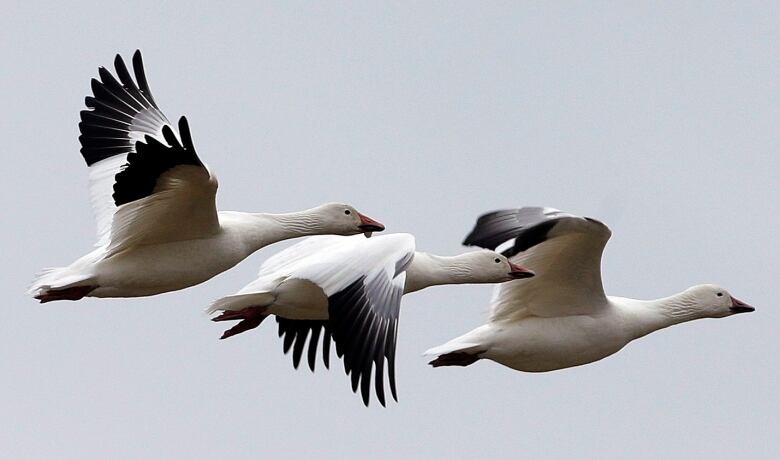Exploding Arctic snow geese numbers stabilizing, but still high
Nesting colonies are now so large the birds are destroying their own habitat

After more than a decade of devastating huge swaths of Arctictundra, booming populations of snow geese may have finallystabilized.
But scientists say the teeming flocks, which have turned fertilegrasslands into salty mud flats, are still at unheard-of levels andhave forced wildlife managers to consider a whole new problem.
"We've always wanted more (wildlife) and protected them andsaved them and increased their numbers," said Dave Duncan, managerof population conservation for the Canadian Wildlife Service. "Justin the last little while wildlife management is faced with this newconundrum of overabundant species.
"How do we deal with it?"
In the last 20 years, new farming methods have resulted in betterfood supply along the big white birds' migration routes and theirpopulation has responded.
In the 1970s and '80s, there were between two million and threemillion snow geese in central North America. Now there are about 15million.
Incredible destruction
Nesting colonies now are so large the birds are destroying theirown habitat.
"It's incredible," said the National Wildlife Research Centre'sPaul Smith, who studies the birds on Nunavut's Southampton Island.

"They'll convert an area that was once covered in grass toexposed mud. When this mud is left exposed, the evaporation rategoes up and you get this salt crust on the top. Then it's verydifficult for plants to recolonize those areas."
In the Queen Maud Bird Sanctuary along the central Nunavut coast,ground exposed by the birds went from 200 square kilometres in 1988to about 1,300 square kilometres by 2011.
Years of relaxed hunting rules up and down the migration routedidn't help much.
But something seems to have finally stalled growth, saysEnvironment Canada scientist Ray Alisauskas.
"It appears that the population may be stabilizing, but notbecause of reductions in survival of adults. It's this density
dependence that reduces the number of young per adult."
Habitat recovering
There's more good news. Duncan said that at least some ravagedcolony sites along the west coast of Hudson Bay appear to berecovering.
Still, 15 million snow geese are enough to significantly alterthe Arctic ecosystem.
Some birds, such as sandpipers or longspurs, appear to sufferfrom huge flocks. Others, such as king eider ducks, seem to benefit.Polar bears, forced off the sea ice earlier and earlier, arelearning to stuff themselves on goose eggs.
A cull? The logistics are challenging what do you do with twomillion dead birds? and the costs are high.
Scientists believe the best plan is to monitor the swollen flocksand to look around the rest of the Arctic to see where else theymight colonize.
"We don't know enough about the magnitude and extent of thedamage in the Arctic," said Duncan.
"Environment Canada's position is to more fully understand theextent of the impact of snow geese on the broader ecosystem, notjust at local levels ... before going that route of a cull,"Alisauskas said. "We want to understand the science a lot betterthan we do."
Drawing the line
The concept of weighing one species against another, of nurturingnature into sustainability, is a new one for wildlife managers.
"One hundred years ago, wildlife management was all about savingand conserving populations," Duncan said. "Only in the last decadeor two have we got these superabundant species deer in New York,too many ring-billed gulls in Toronto, or too many coyotes."
Nobody knows where to draw the line between natural use andoveruse, said Smith.
"Geese are a natural part of the Arctic so you expect some ofthis to be happening. The question is, where's an acceptablelimit?"












_(720p).jpg)


 OFFICIAL HD MUSIC VIDEO.jpg)
.jpg)



























































































